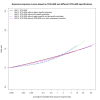Respirable crystalline silica and lung cancer in community-based studies: impact of job-exposure matrix specifications on exposure-response relationships
- PMID: 38264956
- PMCID: PMC11064806
- DOI: 10.5271/sjweh.4140
Respirable crystalline silica and lung cancer in community-based studies: impact of job-exposure matrix specifications on exposure-response relationships
Abstract
Objectives: The quantitative job-exposure matrix SYN-JEM consists of various dimensions: job-specific estimates, region-specific estimates, and prior expert ratings of jobs by the semi-quantitative DOM-JEM. We analyzed the effect of different JEM dimensions on the exposure-response relationships between occupational silica exposure and lung cancer risk to investigate how these variations influence estimates of exposure by a quantitative JEM and associated health endpoints.
Methods: Using SYN-JEM, and alternative SYN-JEM specifications with varying dimensions included, cumulative silica exposure estimates were assigned to 16 901 lung cancer cases and 20 965 controls pooled from 14 international community-based case-control studies. Exposure-response relationships based on SYN-JEM and alternative SYN-JEM specifications were analyzed using regression analyses (by quartiles and log-transformed continuous silica exposure) and generalized additive models (GAM), adjusted for age, sex, study, cigarette pack-years, time since quitting smoking, and ever employment in occupations with established lung cancer risk.
Results: SYN-JEM and alternative specifications generated overall elevated and similar lung cancer odds ratios ranging from 1.13 (1st quartile) to 1.50 (4th quartile). In the categorical and log-linear analyses SYN-JEM with all dimensions included yielded the best model fit, and exclusion of job-specific estimates from SYN-JEM yielded the poorest model fit. Additionally, GAM showed the poorest model fit when excluding job-specific estimates.
Conclusion: The established exposure-response relationship between occupational silica exposure and lung cancer was marginally influenced by varying the dimensions of SYN-JEM. Optimized modelling of exposure-response relationships will be obtained when incorporating all relevant dimensions, namely prior rating, job, time, and region. Quantitative job-specific estimates appeared to be the most prominent dimension for this general population JEM.
Conflict of interest statement
The authors do not declare any conflict of interest. TB, BK and TBr, as staff of the Institute for Prevention and Occupational Medicine (IPA), are employed at the “Berufsgenossenschaft Rohstoffe und chemische Industrie” (BG RCI), a public body, which is a member of the study’s main sponsor, the German Social Accident Insurance. IPA is an independent research institute of the Ruhr-Universität Bochum. The authors are independent from the German Social Accident Insurance in study design, access to the collected data, responsibility for data analysis and interpretation, and the right to publish.
Figures
Similar articles
-
A less detailed job axis in a quantitative job-exposure matrix results in a similar exposure-response association.Occup Environ Med. 2025 May 18;82(3):157-160. doi: 10.1136/oemed-2024-109702. Occup Environ Med. 2025. PMID: 40122614 Free PMC article.
-
Sensitivity analyses of exposure estimates from a quantitative job-exposure matrix (SYN-JEM) for use in community-based studies.Ann Occup Hyg. 2013 Jan;57(1):98-106. doi: 10.1093/annhyg/mes045. Epub 2012 Jul 17. Ann Occup Hyg. 2013. PMID: 22805750 Free PMC article.
-
SYN-JEM: A Quantitative Job-Exposure Matrix for Five Lung Carcinogens.Ann Occup Hyg. 2016 Aug;60(7):795-811. doi: 10.1093/annhyg/mew034. Epub 2016 Jun 9. Ann Occup Hyg. 2016. PMID: 27286764
-
Assessment of exposure in epidemiological studies: the example of silica dust.J Expo Sci Environ Epidemiol. 2008 Sep;18(5):452-61. doi: 10.1038/sj.jes.7500636. Epub 2007 Dec 5. J Expo Sci Environ Epidemiol. 2008. PMID: 18059424 Review.
-
Pooled exposure-response analyses and risk assessment for lung cancer in 10 cohorts of silica-exposed workers: an IARC multicentre study.Cancer Causes Control. 2001 Nov;12(9):773-84. doi: 10.1023/a:1012214102061. Cancer Causes Control. 2001. PMID: 11714104 Review.
Cited by
-
Five decades of occupational cancer epidemiology.Scand J Work Environ Health. 2024 Oct 1;50(7):489-502. doi: 10.5271/sjweh.4190. Epub 2024 Sep 23. Scand J Work Environ Health. 2024. PMID: 39311490 Free PMC article. Review.
-
A less detailed job axis in a quantitative job-exposure matrix results in a similar exposure-response association.Occup Environ Med. 2025 May 18;82(3):157-160. doi: 10.1136/oemed-2024-109702. Occup Environ Med. 2025. PMID: 40122614 Free PMC article.
References
-
- Steenland K, Mannetje A, Boffetta P, Stayner L, Attfield M, Chen Jet al. ; International Agency for Research on Cancer . Pooled exposure-response analyses and risk assessment for lung cancer in 10 cohorts of silica-exposed workers: an IARC multicentre study. Cancer Causes Control 2001. Nov;12(9):773–84. 10.1023/A:1012214102061 - DOI - PubMed
-
- Checkoway HP, Kriebel D. Research methods in occupational epidemiology. 2nd ed. 2004.
MeSH terms
Substances
LinkOut - more resources
Full Text Sources
Medical
Miscellaneous


